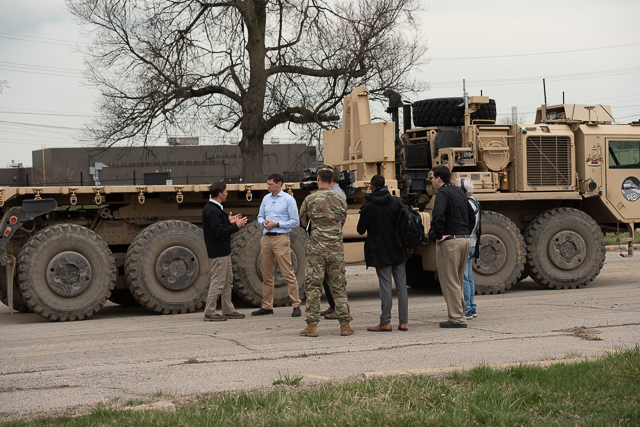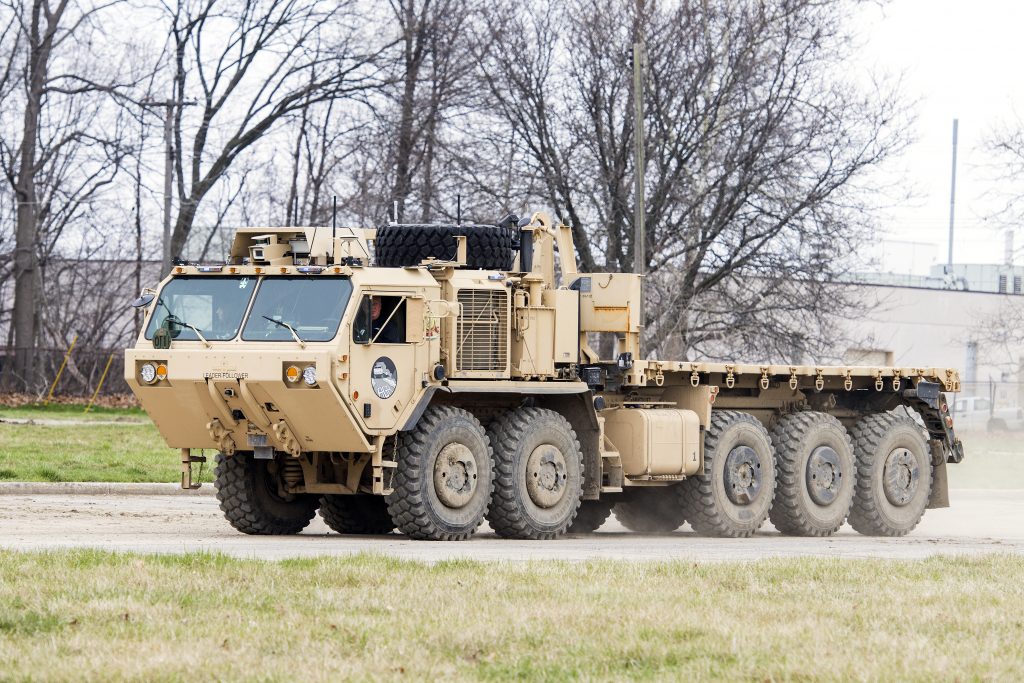
Army Secretary Mark Esper (left) getting briefed on the self-driving “leader-follower” autonomous vehicle (in background).
ATLANTIC COUNCIL: Last Friday, Army Secretary Mark Esper got to ride in a robotic vehicle. Today, describing the unmanned ride, he was clearly enthused about the autonomous technologies on which the Army is staking its future.
“That’s one of the gee-whiz things, that autonomy is available to us,” Esper said this morning at the Atlantic Council. As the Army pursues its Big Six modernization priorities, he said, “autonomy is one of the key technologies. It’s certainly critical to the Next Generation Combat Vehicle,” No. 2 of the six. NGCV will replace the Army’s current armored vehicles — starting with M2 Bradley troop carriers but ultimately including M1 Abrams tanks — with a mix of robotic and optionally manned armored vehicles.

Army HEMTT truck converted to a self-driving “leader follower” vehicle at TARDEC (Tank-Automotive Research, Development, & Engineering Command) in Warren Mich..
RoboTruck
Admittedly, the machine Esper encountered at Tank-Automotive Research & Development Command (TARDEC) in Warren, Mich., was not a robot tank, not yet. It was a large Army truck known as a HEMTT converted to drive itself meekly in convoy behind a manned vehicle — “leader-follower” technology the service has been working on for years.
“If you look back at the Iraq war, one of the most dangerous duties was driving, riding in a convoy between Kuwait City and Baghdad. We lost many, many soldiers, too many soldiers, to IED (roadside bomb) attacks, other attacks on convoys,” Esper said this morning at the Atlantic Council. “I could’ve reduced that vulnerability, that sacrifice, (with) unmanned convoys or convoys that were manned by (only) a couple of soldiers.”
(While Esper didn’t say it, even combat vehicles could benefit from leader-follower technology — for example, to let human drivers rest on long road marches so they can be fresh to fight, or to allow a vehicle whose human crew is incapacitated to follow a friendly unit out of the kill zone).
Playing “follow the human” may seem a step back from the self-driving cars companies like Google and Tesla are developing. But military robots can’t just follow Google Maps or Waze because they have to move cross-country, avoiding obstacles and threats, which makes their navigation problem much harder.

Stryker armored vehicle flipped over by roadside bomb (an Improvised Explosive Device or IED).
Once that problem’s solved, however, robotic convoys could save lives. Once upon a time, supply trucks moved about a relatively safe “rear area” behind the front lines, although irregulars, airstrikes, and panzer breakthroughs were always potential risks. In Iraq, Afghanistan, and in a potential future conflict against Russia — with its mix of precision-guided long-range missiles and infiltrating Little Green Men — there’s no such thing as “safe.” In fact, some of America’s heaviest casualties have come hauling supplies, since convoys had to travel predictable routes along narrow roads that made them easy to ambush.
At TARDEC last week, Esper said “I did have a chance to ride around in an autonomous vehicle. It was being led by a manned vehicle, and we were actually (on a) closed course but we were doing off-road travel,” Esper said. “So you could see right there the promise of autonomy. You could run convoys, for example, you could stack these vehicles up (in line), hauling goods…. from Point A to Point B with maybe only two persons in the lead vehicle.”

Russian Uran-9 armed unmanned ground vehicle
New Partners
“Of course, the commercial sector is moving out” on self-driving vehicles, Esper noted, and the Army wants to learn from them. But military vehicles, even simple supply trucks, face challenges a Tesla never has to worry about — which is why research centers like TARDEC exist.
“Unlike the commercial sector, we have to develop systems that can maneuver off-road, that can maneuver in all elements…. that can navigate obstacles, whether they be trees or gullies or rocks or whatever they may be,” Esper said. If the unmanned vehicles are to be truly autonomous, as opposed to leader-followers, he went on, they must also keep in formation with friendly forces — not just follow one leader — and either keep away from, outflank, or advance on the enemy.

Army autonomous truck experiment
“So it’s very complicated, but you can see the future ahead,” Esper said. “If we can get to that point, it will give us a great deal of capability, an incredible overmatch on the future battlefield.”
“The key is getting there first,” Esper said. He means ahead of Russia and China, named by the new National Defense Strategy as America’s No. 1 “strategic competitors,” who are investing heavily in robotics and Artificial Intelligence.
What about America’s less well-funded allies? asked one British liaison officer in the audience. Should we try to innovate on our own or just wait for America to blaze a trail to follow?
The same Brit had been at Australian Maj. Gen. Mick Ryan‘s discourse last week on this very subject. Ryan had advocated each country conducting its own robotics R&D, but sharing the results as part of a collaborative international effort. Esper seemed to think much the same way.
“I’d ask as you do your research and think about the future, come see us,” Esper replied. “We should have open doors to our allies as well, and share these best ideas.”
“I want to go not only to the traditional defense industry, I want to go to the non-traditional industry, and I want to talk, I want to work closely, with the allies and partners,” Esper went on. “It’ll be really good if we can figure out; it will be even better if all of us can figure it out.
“If you had a hard time getting in, just tell them I told you to come visit,” Esper told the British officer.
Sullivan: Defense industry ‘still underestimating’ global need for munitions
National Security Advisor Jake Sullivan said that there are “no plans” for another Ukraine supplemental at this point.


























